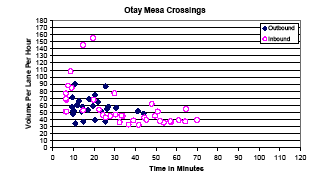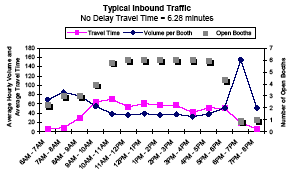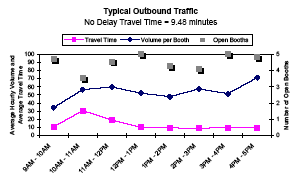Otay Mesa Crossing Summary
The Otay Mesa Port of Entry (POE) connects San Diego, California and vicinity with Tijuana and Western Baja California, Mexico. On the U.S. side, the Otay Mesa crossing connects with State Route 905 (Otay Mesa Road), providing links to I-805 and I-5. The commercial traffic crossing the border at Otay Mesa includes a mix of agricultural products and supplies and finished products related to the Maquiladora (twin-plant) industry that is continuing to thrive.
Northbound (inbound) traffic heading to the U.S. travels westbound along Avenida Internacional, parallel to the border, as it approaches the Mexican Customs export compound. Once at the export compound, empty vehicles stay to the right while loaded vehicles loop around the secondary inspection facility to the left and pass through the primary export inspection. A small percentage of vehicles are sent back to the secondary export inspection. Only empty vehicles are processed from 6 am through 8 am during the week; all vehicles are processed from 8 am to 5:30 pm, while loaded vehicles are given priority; and from 6 until 8 pm, only empty vehicles are again processed.
Southbound (outbound) vehicles head south on La Media road toward the border where they make a left turn and travel adjacent to the border until they reach the U.S. Customs export facility. Certain vehicles, including tankers that need to be weighed, enter the export facility while others turn right and head directly through the U.S. export booths and into Mexico. On the Mexican side, they travel through the primary inspection booths (see Figure 4), where they are either cleared for release or sent to secondary inspection. Hours of operation for the Mexican commercial import facility are from 9 am to 5 pm. In-bond vehicles first visit a special, segregated area for processing before they pass through the primary Mexican Customs inspection booths. They may remain in the in-bond area for hours, days, or occasionally, even weeks.
| Baseline Time[1] | Average Crossing Time[2] | 95th Percentile Time[3] | Buffer Time[4] | Buffer Index[5] | |
|---|---|---|---|---|---|
| Outbound | 9.5 | 19.1 | 36.9 | 17.8 | 93.2 |
| Inbound | 6.4 | 35.0 | 64.3 | 29.3 | 83.7 |
Notes:
- Baseline time (in minutes) to travel the study distance (between the starting point in the exporting country and the initial inspection point in the importing country) in free-flow traffic conditions.
- Average crossing time (in minutes) to travel the study distance.
- Time (in minutes) for 95 percent of trucks to travel the study distance.
- Time (in minutes) between the average time and the 95th percentile time for trucks to travel the study distance. This is the "extra time" that must be budgeted to cross the border relative to the average time.
- Buffer time necessary expressed as a percentage of average time. This is the extra percentage of average time that must be budgeted to cross the border.


